Nickolas Hight's Blog
August 17, 2020
Archery Redux
A blog post in which I restate what other people have restated about stuff that is worth restating in the world of late 14th century warfare, in particular, the never-ending debate on arrows vs armor ...
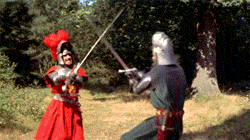
This is a great GIF, but back in the day these two stalwarts never would have flailed around with raised visors ...
I was down in the YouTube rabbit hole looking for blog inspiration when I happened upon a newish post from Matt Easton of Scholagladiatoria. And his video was a rather lengthy piling-on of a previous video made by Tod's Workshop, in which a renowned bowyer/fletcher and archer see what arrows can do against a cuirass made by a renowned armorer, all while a renowned professor provided commentary. In short, the arrows lost. The cuirass endured. The point being, knights encased in plate armor during the Hundred Years' War were nearly invulnerable ... At least, their cuirasses were.
This is the point Matt Easton makes in his (kind of lengthy but interesting) video. He brought up a few other good ones, too. The whole 'arrow storm' or massed volley theory has been discounted as being ineffective due to the massive drop-off in velocity and penetrating power of heavy war arrows. Archery at Crecy and Poitiers and Agincourt was up-close and personal. And just because knights had really effective cuirasses didn't mean archers would target them there. A smart archer shot the knight's horse. Or rang the knight's bell with a shot to the head. Or incapacitated with arrows shot into arms and legs.
Another good point brought up by Easton is, the majority of combatants in Hundred Years' War armies were not armored as heavily as knights. Arrows were highly effective against gambeson, aketon, mail, and brigandine. A previous video I shared from Tod's Workshop showed how effective arrows were against shields. I mean, I would not have wanted to be a common foot soldier trying to close the English lines when the arrows started coming in from fifty yards away. Makes you feel for the Genoese crossbowmen at Poitiers.
Enough from me. I'll let Matt Easton do the talking ...
https://www.youtube.com/watch?v=SWBUFvQvOBQ
August 3, 2020
The Visconti

This is the sarcophagus of Bernabò Visconti, the wacky, madcap ruler of Lombardy for a substantial chunk of the 14th century. And when I say whacky, I mean whacky. Bernabò and his only slightly less unsavory younger brother, Galeazzo, were co-rulers of a substantial chunk of northern Italy. Bernabò was based in Milan; Galeazzo ruled the city of Pavia. They picked fights, brutalized their subjects, muscled in on their neighbors, disregarded the Church ... In general, they were malignant rabble-rousers and horrible human beings. They were also, paradoxically, patrons of the arts who sort of helped usher in the Renaissance. And they were also related by marriage (for a brief time) to Edward III, King of England. It only followed Bernabò would be the primary foil for Angelo Anchioni and Stuart Heton. In many ways, writing his POV is far easier than other characters. He just wanted to dominate Italy, screw the French, confound the Church, do whatever he wanted, and kill whoever crossed him. Not too complicated. Horrible. But not too complicated.
My point is, some writers struggle to invent complex villains. That wasn't necessary with the Visconti, as some of they things they got away with are the stuff of nightmares. Plague victims walled into their homes. People fed to their hunting dogs. Oppression. Brutality. Assassinations. And of course, they didn't keep crocodiles in the dungeon of Visconti Castle in Milan. But there's certainly room for crocodiles in that castle; it's enormous. And if anyone in the mid-to-late 14th century would have kept crocodiles and fed people to them, it sure would have been Bernabò.

Nightmare ...
July 28, 2020
Even More Archery
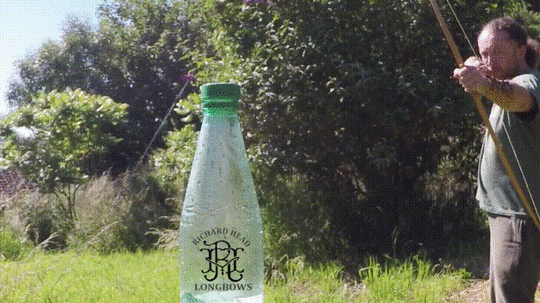
Best archery GIF ever? Maybe.
As stated in previous posts, I enjoy archery despite not having drawn a bow since a trip to the renaissance festival in Larkspur, Colorado about a thousand years ago.
When I sat down and actually started researching VENDETTA, I realized archaeologists had come a long way in correcting the historical record. Mike Loades wrote an excellent book on English war bows, published by Osprey. It's served as a primary resource for me and, quite frankly, I like to think it's saved me from making a lot of silly mistakes when writing about archery.
Check it out on Amazon:
Loades wrote a book about composite bows, as well, but IMHO it's not quite as engaging.
Meanwhile, Tod's Workshop has produced a new series of videos which highlight penetrating power of arrows. He also applied beeswax to his arrowheads to improve their penetration and reasoned Medieval archers might have done the same thing. The results were pretty eye-opening. The experiment made me think about a fight scene in VENDETTA which described Angelo Anchioni and Stuart Heton deflecting arrows or absorbing them with shields. I mean, a re-write is out of the question. But I'll definitely keep it in mind while hammering away at END OF DAYS.
https://www.youtube.com/watch?v=y6IlEUm_Eo4
July 24, 2020
War Dog

This is Luca, the mighty war dog, flopping awake after a snooze in the sedge. Well ... he thinks he's a mighty war dog. He's more along the lines of 25 pounds of stubborn dingbat. But this is what happens when a mighty war dog is trapped in a little terrier/dachshund body.
Luca likes to sit on my lap while I write, imposing his will on my muse. Or getting in the way of the keyboard, depending on your perspective. When not on my lap and pointing out plot holes, he hangs out under my desk waiting for a break in the action. A harsh taskmaster, is Luca ...
For those of you who read it, you're aware a war dog appears in VENDETTA (Baci, a brindle cane corso and fan favorite ... of my three fans, that is). Baci will of course continue romping through the Emilia-Romagna in END OF DAYS. And a few other canines will make hair-raising appearances, as well.
Dogs rarely appear as fleshed out scene-stealers in a lot of the period-specific genre stuff I read. Maybe I'm just not reading the right books as I'm sure I cannot be the only writer out there working on Medieval historical fiction who has a dog as a strong supporting character.
In any case, as they do now, dogs played a major role in the lives of everyday folks back in the 14th century. Guard dogs, sheep dogs, hunting dogs, lap dogs, working dogs, stray dogs, war dogs, from small rat terriers (like Luca who would never forgive me for describing him as a rat terrier) to massive, 150-pound Alaunts (spoiler alert: a pair of Alaunts appear in END OF DAYS).
Now enjoy this photo of Luca's arch-rival, Hannah, as she maintains focus on the peach tree in the back yard. The watchword is vigilance. The enemy never sleeps. Commandos of the United Squirrel Liberation Front are always on the prowl ...

The fruit must be protected ...
July 10, 2020
Hawkwood
Behold! Medieval carnage ...
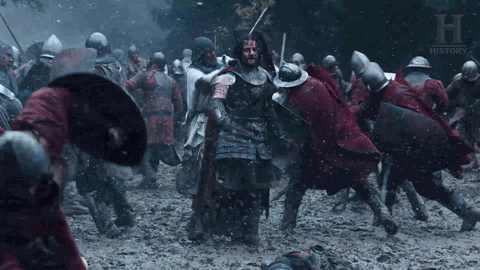
What does this GIF have to do with Sir John Hawkwood? Nothing. It's just my little attempt at an attention getting device. This is from some show about Templars on the History channel, and is stunningly inaccurate, as the two lead characters aren't wearing helmets. They would have been dead within the first seconds of any pitched battle.
The Templars were wiped out in the early 14th century by the king of France and the pope, who wanted the Templar's substantial wealth and properties (way to go, Phillip IV and Clement V). Blah blah blah. Not at all related to Hawkwood ...
Every great once in awhile (like, really infrequently), a kind soul asks about my writing. And they usually ask, 'Why Hawkwood?' Well, there are a number of reasons but the foremost one is, I just find him a fascinating figure. He left England at a young age and never returned, though he meant to, particularly near the end of his life. He fought in two pivotal battles of the Hundred Years War, Crecy and Poitiers. He revolutionized warfare on the Italian peninsula, as well as the system which hired and payed mercenaries. He survived successive waves of plague, numerous battles, and campaign season after campaign season. He had a reputation for honesty (though he did frequently change employers). He was by turns recognized for his tactical prowess and berated for savagery, depending upon whose employ he was in. And he rubbed elbows with all the major players of the day. Popes were terrified of him. The Visconti family hired him, fired him, and hired him again. He married a daughter of Bernabò Visconti. Then got fired again. Florence made him a citizen of the commune. Queen Joana of Naples gave him a life-long pension. He met Chaucer and Petrarch. Fought alongside the Baron Enguerrand de Coucy, (son-in-law of Edward III and one of France's most renowned knights). He was an agent (for a brief time) of King Richard II. He ran amok in Italy for the better part of thirty years, and the Italians never quite managed to figure him out. He was larger-than-life. By turns violent and gracious. Who needs to create a fictional character when someone like this was running around in the 14th century?!
It was a no-brainer to have Hawkwood's relationship with the Visconti family of Milan serve as a backdrop for my first novel, VENDETTA (that and the fact no one else has done anything like it). The events in VENDETTA ended in June, 1377, right after Hawkwood's marriage to Donnina Visconti. My second novel, END OF DAYS, picks up right where VENDETTA left off and will carry the reader into 1378, in which all sorts of awful things happened and sort of culminated in the terrible Papal schism which took place in August of that year.
What's that? You want a sample from END OF DAYS? Well, if you insist ...
June 30, 2020
Welcome to the swamp ...
... that is my writing process.

This isn't really a swamp. Nor is it representational of my writing process (murky, smelly, surrounded by clouds of mosquitoes). My day job as a park ranger (that's ranger, not rager) allows for some pretty good photo opportunities. The trail system along one of the local creeks never disappoints, but is especially photogenic in the evening.
The water isn't particularly healthy, as it's chock-full of agricultural run-off. But it's also chock-full of life. There are turtles (way too many of them), catfish, bass, blue gill, an occasional loon, ducks, Canada geese, and even a couple of beaver who inhabit this particular stretch of the creek. The banks are steep and clotted with blackberry brambles so humans can't hang around comfortably. If they could, the creek banks would be infested with garbage because if there's one thing humans like to do, it's drop trash in an effort to prove they hung out somewhere. I suggested to a resident that what the creek really needs is a couple of alligators. Apparently, it's been done (as some people see creeks as dumping grounds for unwanted animals) but they can't survive through the winter. So unfortunate. Sometimes, I'd like nothing better than to see a 15-foot long dinosaur snatch an unlicensed angler right off the bank. Kidding. I'm kidding. Not really.
And now, partake of my local ecosystem/biome, vicariously ...


Get outside and enjoy your parks, be they local, state, or national!
June 27, 2020
More Archery
Here's another shameless plug for a video produced by Tod's Workshop, this one offering good descriptions of the types of arrowheads used by Medieval archers.
The mass production of arrowheads -- the whole bowyer industry in fact -- was highly efficient, and a respected trade. It had to be to support the large numbers of archers English who were mobilized nearly every fighting season to support operations in France, Scotland, or Wales.
Still, like any mass-scale effort, inefficiencies appeared in the final products: warped or unseasoned arrow shafts, brittle or improperly brazed arrowheads, poor fletching. Similar issues were found with bow staves, the production of which in England was a royal monopoly. The crown controlled all imports of yew. Most of the timber for bow staves came from Spain and Italy.
It wasn't enough for archers to develop the strength and coordination to ply a bow. They also had to possess the skills to maintain whatever the royal armories provided them with for a campaign. I like to think many archers could braze arrowheads, craft their own bow strings, repair or fabricate arrow shafts and nocks, fletch arrows, and given time and access to raw materials, shape new bow staves. And in addition to all of that, they had to be proficient in whatever personal weapons they carried: sword, falchion, axe, etc.
https://www.youtube.com/watch?v=McnKrV0aDjo
June 15, 2020
Archery
I've always been fascinated with bows. I had a couple growing up. Nothing serious, not even the sucker-tip arrows one of my brothers popped me in the forehead with while I was walking by the bathroom one day. I got a recurve model that could send an arrow about 100 yards. I would launch arrows (full length but with rubber tips) from the lawn next to my apartment building onto the lawn of the elementary school across the street. Probably one too many viewings of the The Adventures of Robin Hood served as inspiration ...
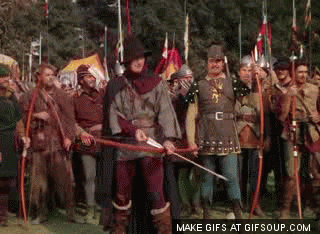
It followed that archery would feature in my writing. As I began to conduct research for VENDETTA (in which archery doesn't play a very prominent role), I discovered a lot of myth-busting had taken place regarding the employment of war bows (long bow is not the proper terminology ... not for the 14th century). Advancements in ballistic technology and subsequent discoveries by amateur and professional historians/archaeologists shed much more light in just how much damage a heavy war arrow launched from a self bow with a 160lb draw weight (or even heavier) could inflict on a fully armored knight. Turns out the descriptions of clouds of arrows filling the skies, of massed ranks of English archers shooting in unison, were not quite correct.
Without getting too much into the weeds, the effective velocity and penetrating power of an arrow drops precipitously after 40 or 50 yards. At Crećy and Poitiers, the English weren't firing volleys of arrows at targets two to three hundred paces distant. They were instead hitting French cavalry and dismounted knights at much closer ranges. Too far and arrows would just shatter or bounce off their target's armor. ,At close ranges, even arrows which failed to penetrate plate armor delivered substantial blunt trauma. Archers also tended to target horses. A knight thrown from horseback was easier to kill or subdue. Dead or injured horses also disrupted advancing ranks.
Another consideration I never took into account was how exhaustive combat shooting could be for archers. English archers began their training fairly young. It took years to develop the reflexes, coordination, and back/shoulder strength to master the heavy draw weights required for combat shooting. Even so, pulling a bow with a 170lb draw weight wiped out an archer after a dozen or so well-aimed shots. Instead of a static line of archers, I envision something a little more fluid took place. Exhausted bow men would back off the line to recuperate. Rested archers would replace them. This also -- IMHO-- is one of the reasons why English armies during the Hundred Years War had such huge contingents of archers in their ranks.
So! Let the experts show you how it's done. War bow versus plate armor ... Check out this great video from Tod's Workshop on YouTube.
https://www.youtube.com/watch?v=DBxdTkddHaE
June 8, 2020
The Castello Visconti
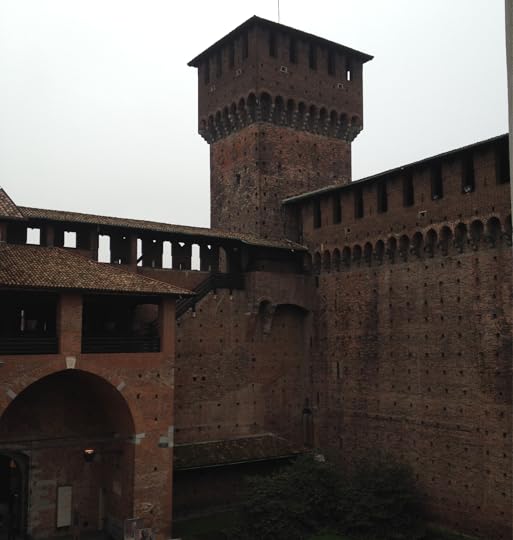
Why take pictures of cool places in Italy if I'm not going to share them? Here is a tiny portion of the Castello Visconti. It became the Castello Sforza in the 15th century; wrong time period for me, though. It was magnificent. Huge. Sprawling. Great museums. If you read VENDETTA, you know harrowing things took place within the castle walls. If you have yet to read VENDETTA, I won't spoil it for you.
Getting the setting right in my work is very important. I can (and often do) fudge some of the events and relationships which took place in 1377. But I always try to nail the setting. As if I really need an excuse to go visit Italy for research ...
Other details I try not to screw around with are clothing, armor, and combat. Combat is a bit of a challenge to write about because the current practitioners of medieval martial arts are incredibly contentious. I stick to watching sparring videos and strictly avoid looking at the comment sections. HEMA (Historical European Martial Arts) and ARMA (Association for Renaissance Martial Arts) are a couple of my go-to resources, as are Scholagladiatoria and Tod's Workshop (both on YouTube ... like everything else).
Work has stalled a bit on END OF DAYS. Given everything going on these days it's difficult to not feel guilty about engaging in any sort of creative activity. But I've also sort of lost my way in the story, so I'm flexing my brain pan and working on some military sci-fi short stories. They're a completely different animal. But rest assured, Anchioni and Heton have not been forgotten when last I left them, cleaning up a tremendous mess somewhere in the Apennines ... Reach out to me if you're interested in a sample.
And wherever you happen to be, I hope you're safe ...
May 31, 2020
Italia and other thoughts ...
I'm trying my damnedest, as many others are, to avoid plunging into the treacherous waters surrounding the current state of affairs in this country. I just don't feel as though adding my voice to the argument will amount to squat. But I'm hurting. These are deeply disturbing times. The only time I can ever remember feeling this unsettled was in Iraq. I didn't care for it then; I don't care for it sixteen years later. I heard a good analogy a couple nights ago used by Hassan Minhaj ... "Too many tabs open." I definitely have too many tabs open. Closing them and not reopening them is the tough part. But I must try.
To that end, Italy ...
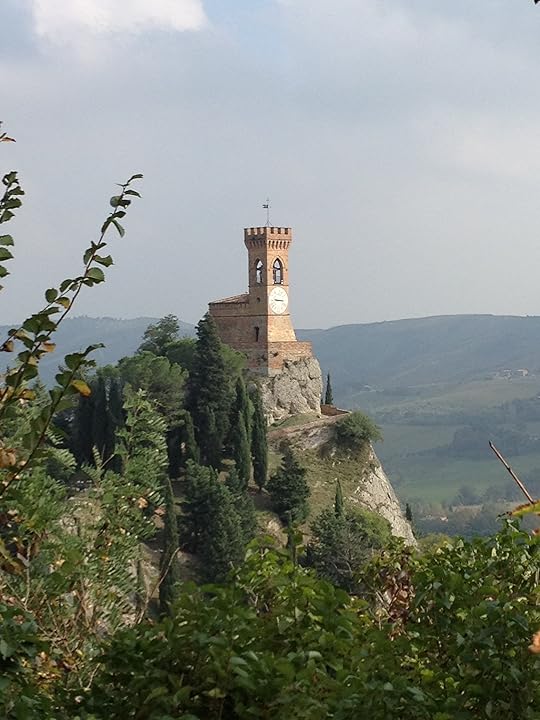
This magnificent watch tower is located above the hill town of Brisighella. It's the lowest of three structures situated above the town, the second being an actual fortress (the Rocco Manfredi). The third is a church. And in End of Days (the sequel to Vendetta), this particular watch tower plays a fairly pivotal role in derailing the (relative) peace and tranquility of Angelo Anchioni and Stuart Heton. Of course, it probably didn't look like this in 1377. But it's historical 'fiction,' so I get a little leeway.
Brisighella is in the Emilia-Romagna, a few miles south of Faenza. If you ever find yourself in that part of Italy, go visit. It will not disappoint. The weekend we happened to be there coincided with a festival celebrating a very old breed of local pigs (Romagnola, maybe). It turned out to be a stunning display of poor planning and crowd control. At one point --when we had finally found a place to sit -- a local lady looked at me, mopped her brow, and said, "Quel disastro!" But the food was magnificent ...



